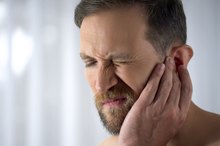Smelly Ear Wax
A sticky substance that helps preserve hearing by coating the ear canals, earwax typically possesses a distinctive, mild odor. Earwax that has an unusual or foul odor generally indicates a problem that could vary in severity from a mild buildup of wax to a potentially serious ruptured eardrum 3. Learn the facts about smelly earwax, including possible causes, accompanying symptoms and your doctor’s most likely course of action.
If you are experiencing serious medical symptoms, seek emergency treatment immediately.
Facts
Earwax moisturizes the sensitive skin lining your ear canals and protects your ears from bacteria and foreign objects. Special glands in the outer third of your ear canal produce the waxy material, which then mixes with sweat and skin cells to create the substance you know as earwax. Earwax can be dry or wet, and it varies in color from black and dark brown to orange and yellow, depending upon factors such as your race, age and overall health.
Causes
Baking Soda & Water for Ear Wax
Learn More
Smelly earwax may arise from multiple causes, including ear infections, compacted earwax and a ruptured eardrum 3. An external ear infection, or swimmer’s ear, often occurs when water gets trapped in your ear canal, leading to a bacterial infection. Compacted wax can build up in your ear regardless of your age, but it typically occurs most commonly in elderly and special needs individuals, according to the American Academy of Family Physicians 2. A ruptured eardrum may develop after a middle ear infection, or it could arise as a result of a head injury, loud noises or abrupt changes in air pressure 3.
Symptoms
The symptoms that occur with your smelly earwax could help indicate the cause of the earwax odor. Ear pain that worsens when you tug gently on the external portion of your ear typically points to an external ear infection, notes MayoClinic.com 4. Pain that gradually increases in severity and then suddenly stops without warning often accompanies ruptured eardrums, especially in children. Other symptoms that could occur with foul-smelling earwax include clear, blood-tinged or pus-colored ear discharge, an earache, noises or ringing in the ear and a partial loss of hearing.
- The symptoms that occur with your smelly earwax could help indicate the cause of the earwax odor.
- Ear pain that worsens when you tug gently on the external portion of your ear typically points to an external ear infection, notes MayoClinic.com 4.
Diagnosis and Treatment
Waterpik Ear Wax Removal
Learn More
In most cases, smelly earwax calls for a trip to your primary care doctor. Your doctor will ask about your symptoms and medical history and use an otoscope to visualize your ear canal and eardrum. In the event that your doctor can’t see your eardrum, she may need to use specialized tools and a microscope to manually remove the earwax that blocks the ear canal. Treatment varies, depending upon the cause of your odorous earwax but may include antibiotics and topical eardrops. In certain cases, your doctor may opt to refer you to an otolaryngologist, a specially trained doctor who provides ongoing care for ear-related health issues.
- In most cases, smelly earwax calls for a trip to your primary care doctor.
- In the event that your doctor can’t see your eardrum, she may need to use specialized tools and a microscope to manually remove the earwax that blocks the ear canal.
Warning
Never try to manually remove smelly earwax yourself in an attempt to determine the cause of your ear problems. Digging into an infected ear with pointed objects like cotton swabs or pen caps could worsen an ear infection or lead to a ruptured eardrum 3. Be sure to let your doctor know if you suffer from diabetes or have ear tubes in place, as manual removal is the preferred wax extraction method in these situations, notes the American Academy of Otolayrngology-Head and Neck Surgery 5.
Related Articles
References
- “Geriatric Otolaryngology”; Karen H. Calhoun and David E. Eibling; 2006
- American Academy of Family Physicians: Cerumen Impaction
- MedlinePlus: Ruptured Eardrum
- MayoClinic.com: Swimmer’s Ear Symptoms
- Mittal A, Kumar S. Role of pH of external auditory canal in acute otitis externa. Indian J Otolaryngol Head Neck Surg. 2014;66(1):86-91. doi:10.1007/s12070-013-0684-0
- Schwartz SR, Magit AE, Rosenfeld RM, et al. Clinical practice guideline (update): Earwax (cerumen impaction). Otolaryngol Head Neck Surg. 2017;156(1_suppl):S1-S29. doi:10.1177/0194599816671491
- Wright T. Ear wax. BMJ Clin Evid. 2015;2015:0504.
Writer Bio
Regan Hennessy has been writing professionally for 11 years. A copywriter and certified teacher, Hennessy specializes in the areas of parenting, health, education, agriculture and personal finance. She has produced content for various websites and graduated from Lycoming College with a Bachelor of Arts in English.








